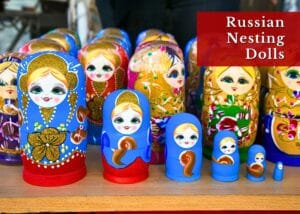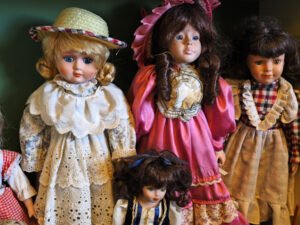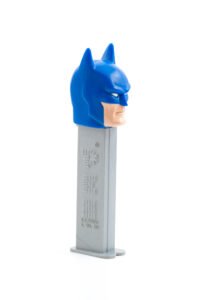If you love Russian folk art, you must have heard of the iconic Russian nesting dolls, also popular as “matryoshka” dolls. Most people think these wooden beauties are just ancient folk artifacts. But they’re much more than that. That’s the first thing you need to know!
What is Russian Nesting Doll (Matryoshka)?
The legacy of Russian nesting dolls started in the late 1800s in an art workshop outside Moscow. Vasily Zvyozdochkin, a toy maker, made wooden figures and an artist painted them like peasant girls with rosy cheeks and a traditional headscarf.
They called her Matryoshka, which means “mother,” who held smaller dolls inside her. People loved this idea. The nesting dolls became popular after winning a prize at the 1900 World’s Fair in Paris.
During Soviet times, the government made them represent all of Russia, not just families.
Then, different time periods brought different styles and themes. Today, Matryoshka dolls are still popular folk art pieces, and collectors value them for their unique background and art.
Key Signs to Identifying Authentic Russian Nesting Dolls
You need a keen eye to spot genuine antique or vintage Russian nesting dolls, since those have way different features from modern pieces, from materials, paint, and construction to themes. Below are the key signs to spot authentic Matrayoshkas:
Materials
The first feature to spot a real Russian nesting doll is its material. Traditional dolls use linden or birch wood. It’s soft, carves easily, and holds paint well. Semyonov dolls use birch. Both should feel smooth and show fine-grain patterns.
Construction
A real matryoshka doll starts as a single block of wood, with the largest doll carved first, then each smaller one carefully made to nest inside. It’s carved from solid wood, no hollow center.
The largest doll should have a flared base, slightly curved inward, for stability and to hold the next smaller one. The dolls should fit snugly but not too tightly. You need a gentle twist to open them. The separation line runs around the middle, not higher or lower; poor copies often get this wrong.
Paint & Finish
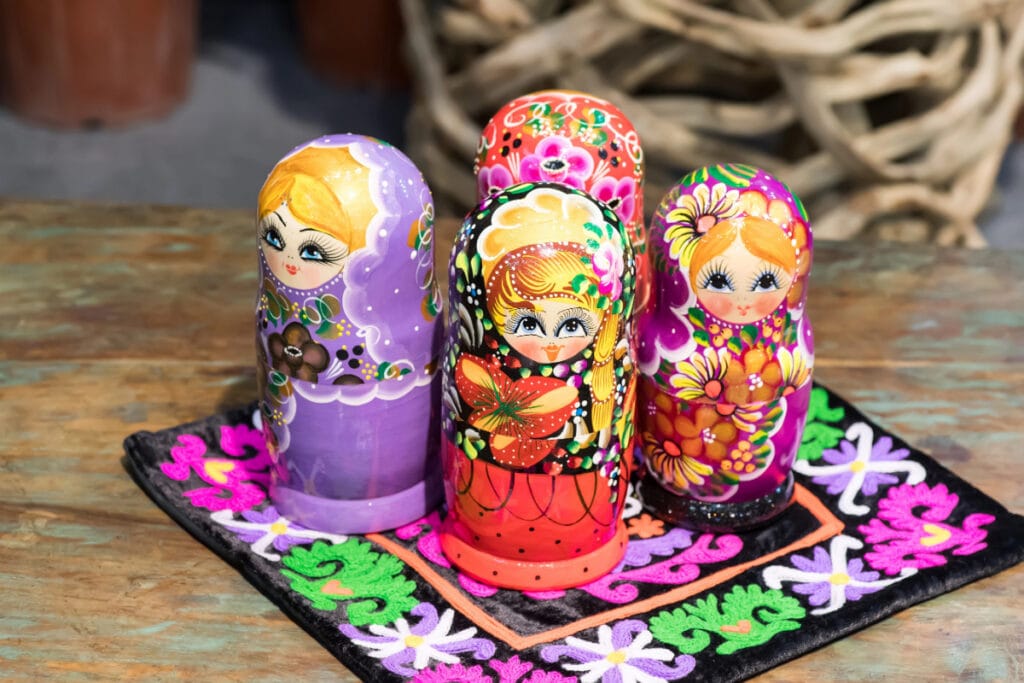
The traditional doll-making process uses gesso (a chalky primer) on the wood before painting. For painting, early dolls used egg tempera and gouache. You’ll see a subtle matte finish with hand-applied lacquer on top. The colors might be faded (normal after 100+ years).
After painting, several lacquer coats protect the paint and create that characteristic aged look. Over time, this lacquer yellows or develops fine cracks, which is a sign of age.
Later pieces used aniline dyes. These stay brighter longer but can look harsh compared to traditional paints.
Markings
Flip the biggest doll over. Authentic examples often show Cyrillic signatures (like “Sergiyev Posad,” “Polkhovsky Maidan,” “Semyonov”), dates, or workshop marks carved or painted on the bottom. These marks prove the authenticity of genuine antique dolls.
However, no signature doesn’t mean fake, but it makes authentication harder. Early pieces may sometimes lack marks, but later tourist pieces mostly do.
Signs of Authenticity
Legitimate nesting doll sets come from the same piece of wood. This prevents warping and ensures a perfect fit. Cheap reproductions often mix different wood types. The pieces don’t nest properly.
Also, real hand-painted dolls, especially older ones, show brushstrokes, slight color bleeding, or tiny pattern variations. The paint might also feel a bit raised. Modern fakes use decals (transfers), showing perfectly smooth, often shiny images.
How to Know Old Russian Nesting Dolls’ Value (5 Factors)
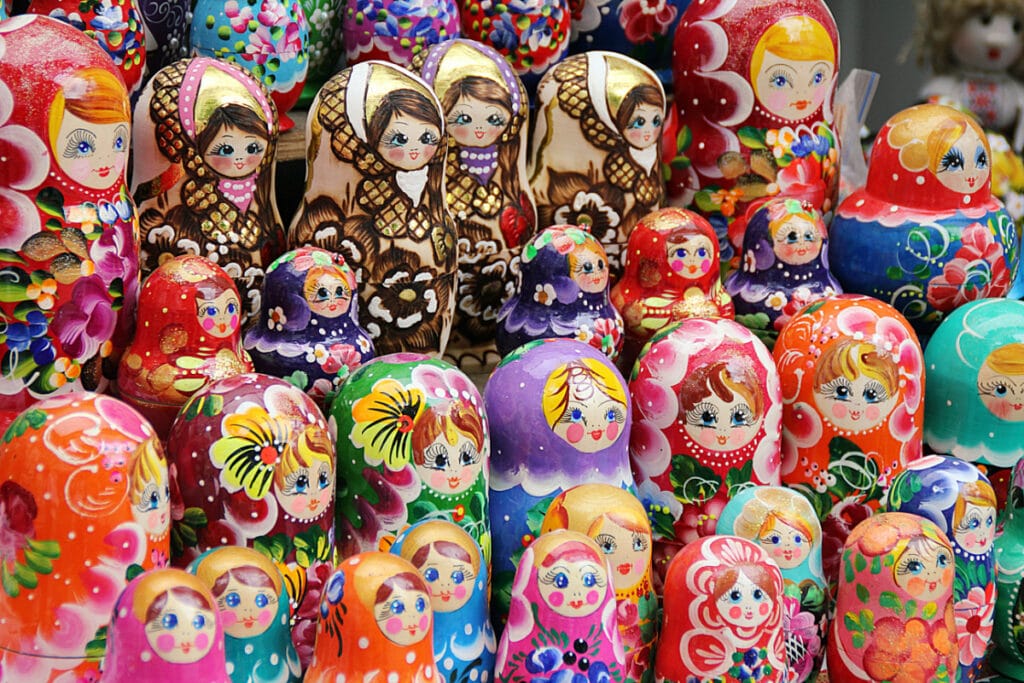
Not all antique Russian Nesting dolls are worth a lot of money, but those with certain features can fetch hundreds. Assess the following factors to find out if you have a valuable set:
1. Age
Generally, pre-revolutionary dolls (made before 1917) are considered rare and valuable because families used them, kids played with them, so most pieces got lost or broken.
The early Soviet period (1920-1940) can also be worth good money. These pieces bridge folk art and state production. The mid-Soviet era (1940-1980) varies wildly. Some factory pieces are beautifully made. Others are tourist junk, not quite valuable.
Modern pieces can be valuable too, but only if they’re artist-signed museum quality. The market is flooded with cheap souvenirs.
2. Artist Signatures
A doll with a readable signature from a known artist can be worth a decent amount. I’ve tracked artists like V. Litvinov, Larisa Chulkova, and Boris Kustodiev reproductions. Their work commands premium prices.
Workshop attribution helps too. Pieces from famous centers like Sergiev Posad carry more weight than generic tourist pieces.
Also, having a documented history, like a paper trail showing where it came from, can further up the price!
3. Condition
Russian nesting dolls in good condition will naturally be more desirable and valuable than those with damage, like paint loss, cracks, etc.
Among these, paint damage kills the most value. I’ve seen $2,000 pieces become $200 pieces because someone tried to “restore” them. Original paint, even if faded, is always better than touched-up paint. So, be careful of dolls that have been poorly restored or repainted.
Also, check for cracks, especially around the separation line. Wood movement over time can cause problems. Minor issues are normal and expected, but major cracks and warping are deal breakers.
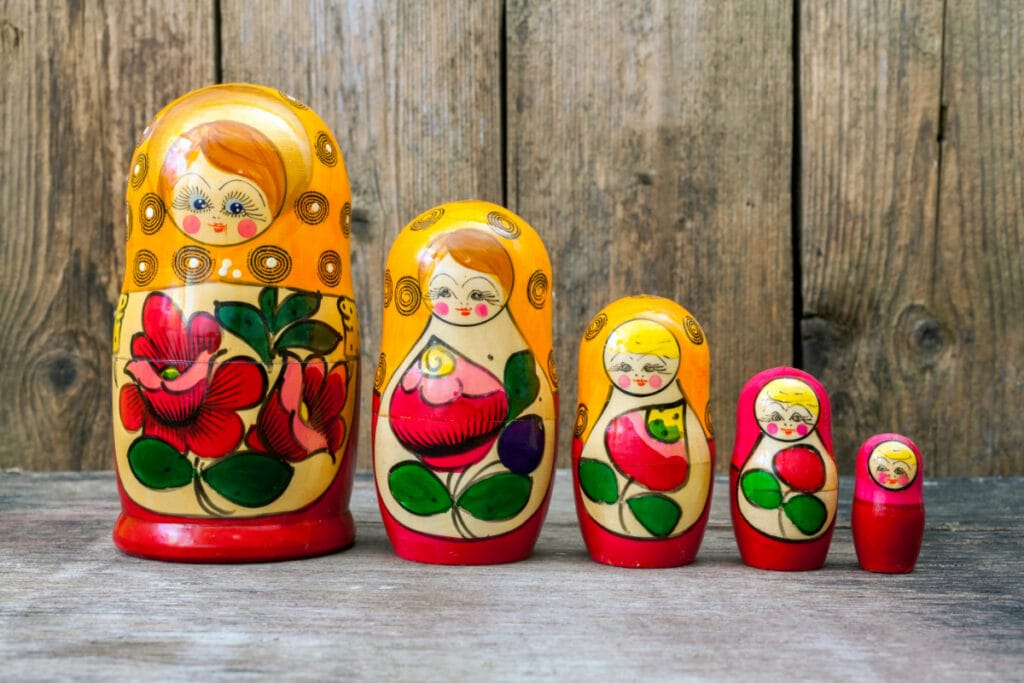
4. Details and Rarity
Certain details and features can significantly boost nesting dolls’ value, such as:
- Fine Painting Work: A doll with detailed, intricate painting, like specific scenes or folk-art designs, is more valuable than one with simple, generic patterns.
- Unusual Subjects: Topics outside the typical peasant girl, such as Russian fairy tales, history’s great figures, religious imagery, or politicians, are greatly sought after.
- Hand-Carved Elements: Dolls with carved details, such as baskets or flowers, can be very rare and very costly.
5. Completeness
Since these dolls come as a nesting set, missing pieces can simply destroy value. A 10-piece set with 8 pieces isn’t worth 80% of the complete set. Piece count also affects price. For example, standard sets have 5-7 dolls, but those with 15+ pieces are special.
Bigger dolls cost more. Pieces over 10 inches tall are considered premium size. Anything under 4 inches is tourist quality unless it’s very early.
Few Examples of Valuable Russian Nesting Dolls from Recent Sales
Below are a few real examples of Russian nesting dolls that sold for interesting amounts in auctions and sales.
1. Henri Bendel New York Russian Nesting Dolls
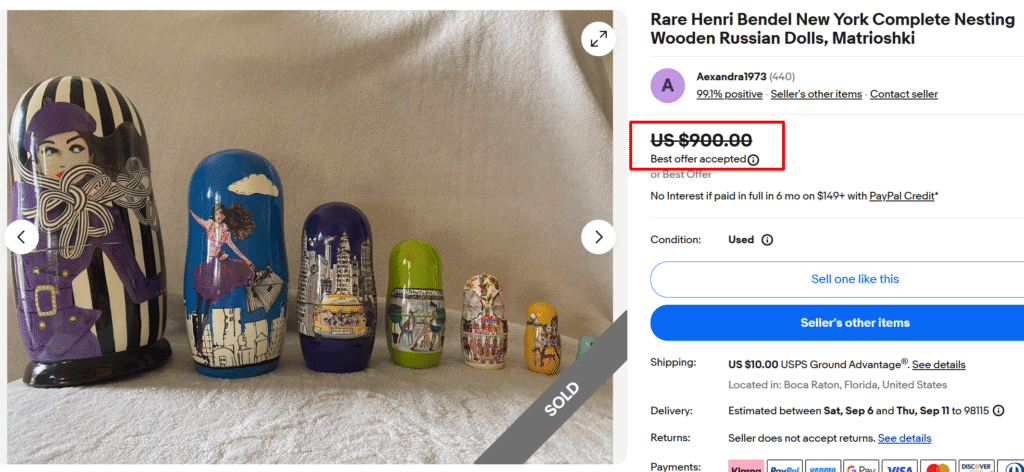
What makes these nesting dolls extraordinary is that they combine traditional Russian nesting doll craftsmanship with New York’s high-fashion aesthetic. These dolls likely feature themes relating to New York culture or fashion, making them coveted pieces for collectors.
These special matryoshka dolls were likely commissioned by the famous New York department store, Henri Bendel, around the 1980s or 1990s when Russian imports became popular.
2. Russian Nesting Doll Set of 7
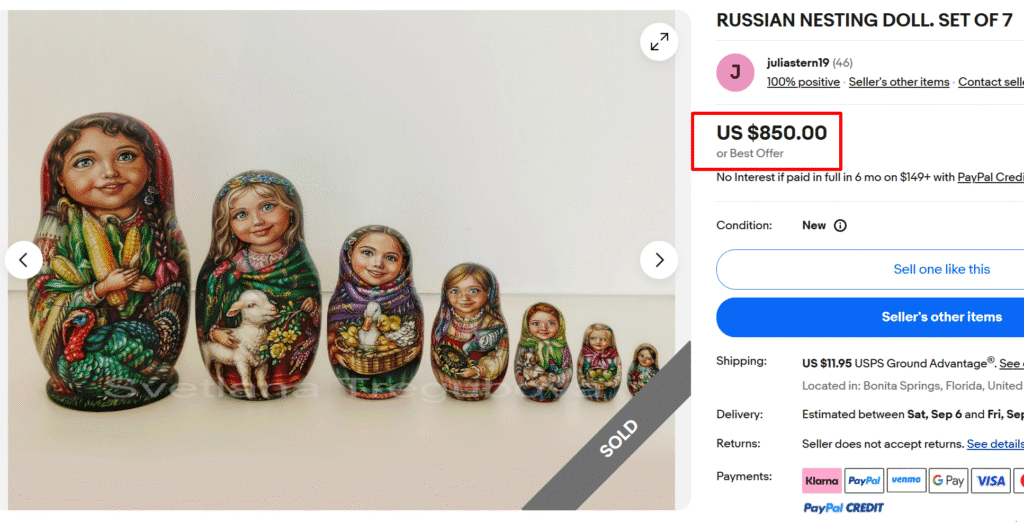
This premium set showcases museum-quality artistry with incredibly detailed hand-painting featuring Russian harvest themes, farm animals, and traditional costumes. The stunning price tag of $850 shows how modern Russian folk art can command serious collector prices with its fine craftsmanship.
3. Large Matryoshka Dolls Set of 26
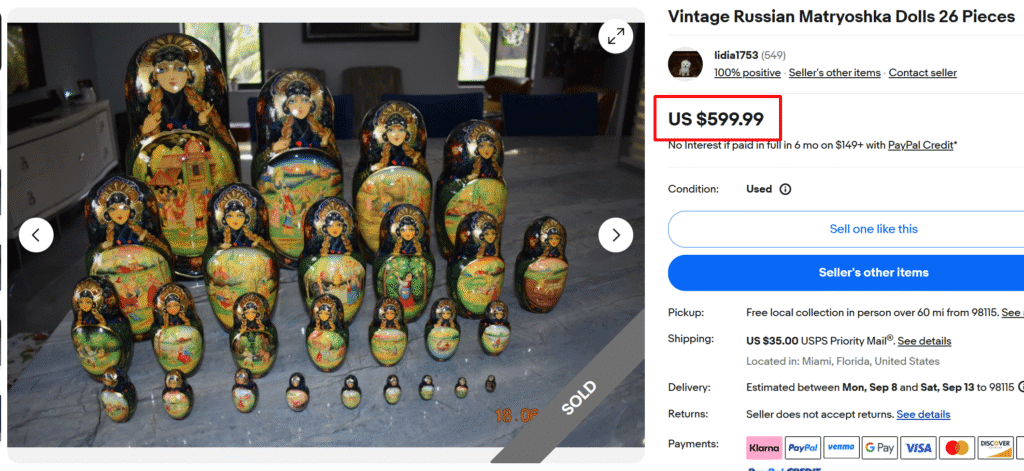
This huge 26-piece nesting doll set show the incredible variety of vintage Russian folk art. Each doll features traditional hand-painted scenes from Russian village life, fairy tales, and peasant families in vibrant colors.
Also, the artwork reflects multiple generations of Russian culture, from traditional sarafan dresses to detailed landscape scenes. Large nesting doll sets are always valuable, no wonder this set sold for nearly $600!
4. Fedoskino Storybook Fairytale Nesting Dolls
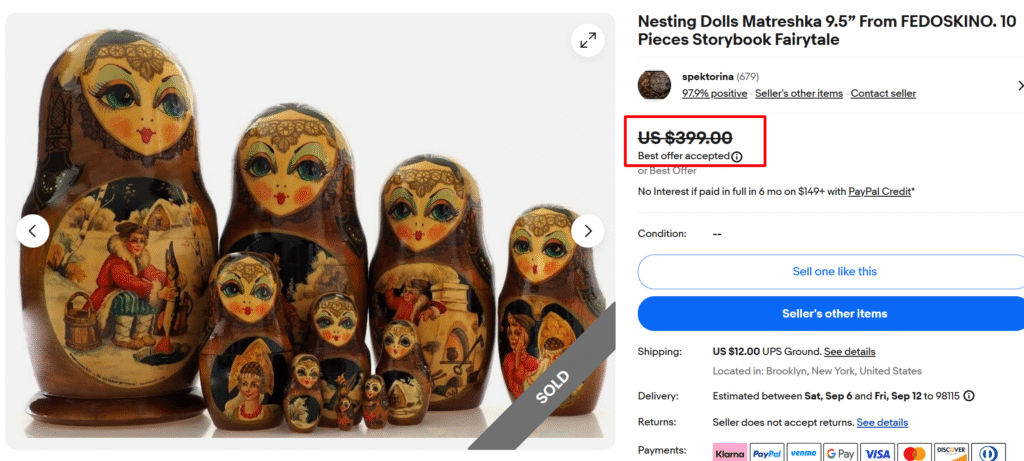
This enchanting Fedoskino set features 10 nesting dolls, with the largest one standing 9.5 inches tall. Each doll displays elegantly hand-painted with full-color scenes from Russian storybooks and fairytales. Fedoskino dolls are known for lacquer artistry and high-detail painting, often signed by the artist. Full sets are quite collectible and sell for $200-$500+!
5. Snow Queen Russian Nesting Dolls Set
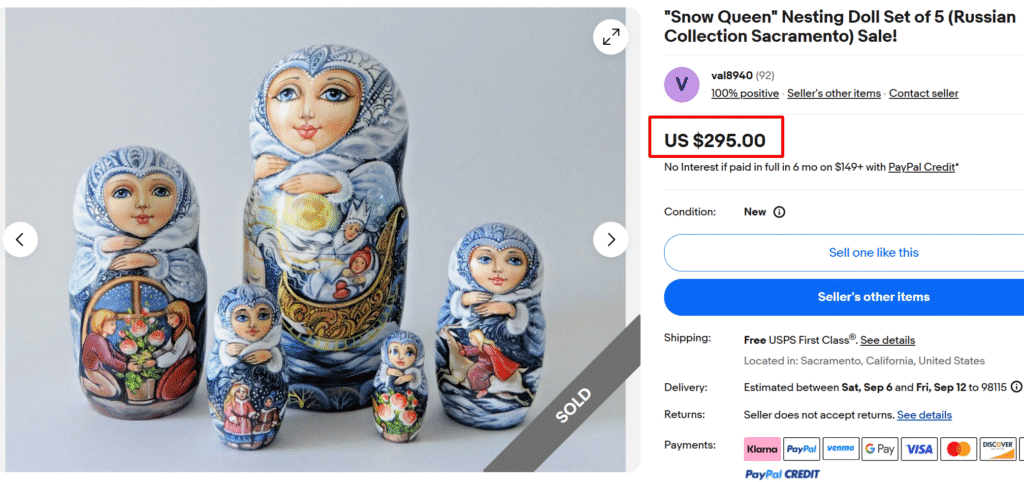
This rare 5-piece Russian nesting dolls set brings Hans Christian Andersen’s beloved fairy tale to life. Each doll features scenes from “The Snow Queen” story, painted in soft blue winter tones.
Made in Sergiev Posad, fairy tale matryoshka dolls showcase the “storybook” quality that makes them so collectible. In good condition, such themed dolls can easily fetch hundreds, like this set sold for almost $300!
6. Sergiev Posad Signed Russian Nesting Dolls
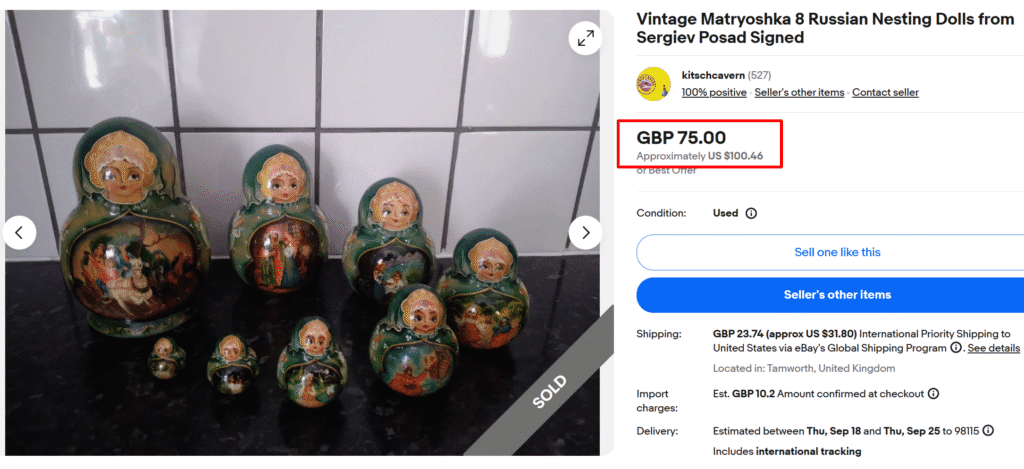
This set comes from Sergiev Posad, the birthplace of matryoshka dolls and home to Russia’s most prestigious woodcarving traditions since the 1890s. These dolls feature the classic green headscarves and traditional Russian scenes that made matryoshka famous worldwide.
Sergiev Posad dolls are considered the gold standard among collectors because they represent authentic craftsmanship from the original workshop region. The artist’s signature can further boost the value!
7. 19th Century Russian Nesting Doll
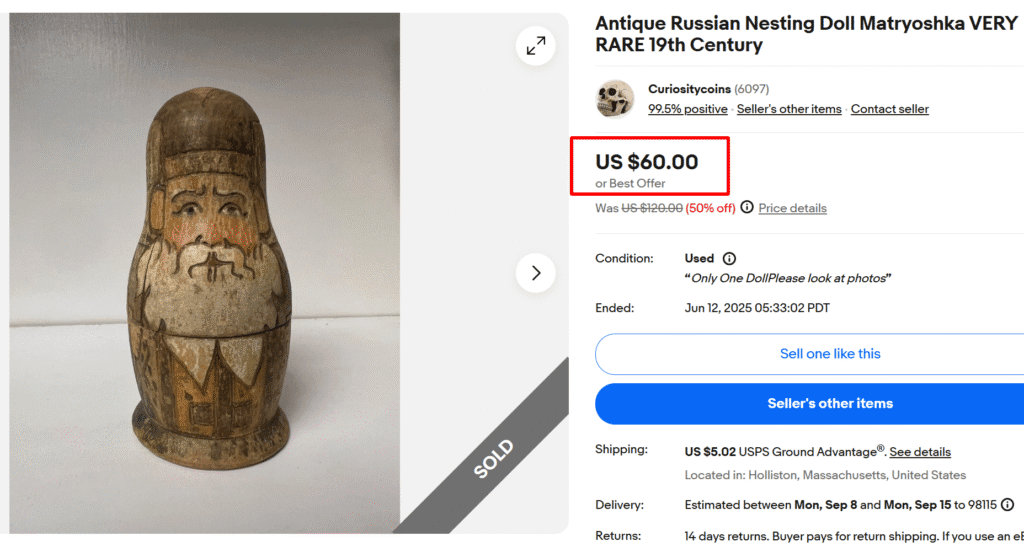
This rare single antique Russian nesting doll likely dates back to the earliest era of matryoshka production. The weathered appearance and simple hand-painted design reflect the original craftsmanship techniques used in the 1890s-1900s.
Unlike modern reproductions, genuine 19th-century pieces with a rustic look and folk art aesthetic are highly collectible. Single pieces themselves can fetch between $30 and $100, and much more for full sets.
Note: This article is intended for informational, educational, and entertainment purposes only. Some images are illustrative and may not represent actual brands, products, or related entities. All trademarks, product names, brand logos, packaging, and other intellectual property referenced remain the exclusive property of their respective owners. Any brand mentions or references are provided solely for descriptive and educational context and do not imply any formal or commercial association.

